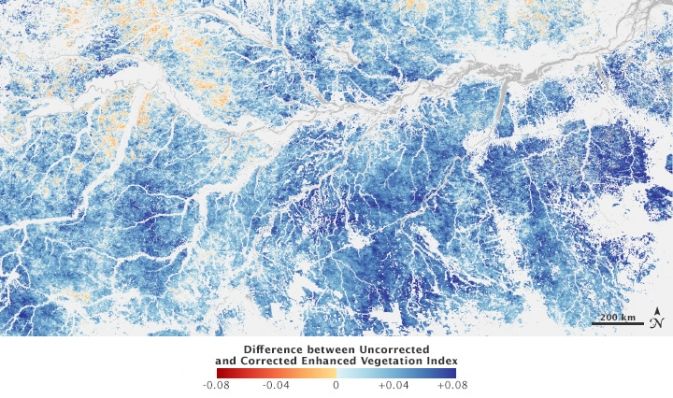Whoops! Amazon Green-Up Actually Satellite Error

Surprising dry season growth spurts spotted in the beleaguered Amazon rainforest are fake, the result of misleading satellite data, a new study finds.
Most plants sprout new growth during wet seasons, and conserve their energy when it's dry. So scientists were surprised when they discovered the Amazon forest turns green during the tropical dry season from June through October —even during an extreme drought — based on data from NASA's Terra satellite. The initial findings were published in the March 22, 2006, issue of the journal Geophysical Research Letters.
But the puzzling dry season growth spurt has long defied explanation, according to a study published yesterday (Feb. 6) in the journal Nature.
The reason why? The forest isn't actually growing, the Nature study reports. Instead, changes in shadow length from June to October made leaves seem greener, throwing off growth estimates. (During growth spurts, trees and plants produce more chlorophyll, which makes them look greener.)
"We think we have uncovered the mechanism for the appearance of seasonal greening of Amazon forests — shadowing within the canopy that changes the amount of near-infrared light observed by MODIS," lead study author Doug Morton, of NASA's Goddard Space Flight Center in Greenbelt, Md., said in a statement. Near-infrared light is just beyond the visible spectrum, and plants with more chlorophyll reflect more near-infrared light.
Here's how Morton and his colleagues diagnosed the problem.
In the tropics in June, the sun is low, casting long shadows when the MODIS, or Moderate Resolution Imaging Spectroradiometer, sensors that fly aboard NASA's Terra and Aqua satellites snap images of the Amazon rainforest. [Biodiversity Abounds: Stunning Photos of the Amazon]
Sign up for the Live Science daily newsletter now
Get the world’s most fascinating discoveries delivered straight to your inbox.
According to MODIS algorithms, an area is likely covered in green vegetation if sensors detect a relatively small amount of red light (red light is absorbed by plants for photosynthesis) but see a large amount of near-infrared light, which plants primarily reflect. Scientists use the ratio of red and near-infrared light as a measure of plant "greenness."
By September, around the time of the equinox, the sun is directly overhead and the forest canopy is shadow-free and highly reflective in the infrared. That makes it appear very green, according to satellite vegetation algorithms, though in reality the forest canopy hasn't actually greened, the study found. Without tree shadow, the forest looks brighter and greener to the MODIS sensors.
"Around the equinox, the MODIS sensor takes the 'perfect picture' with no shadows," Morton said. "This seasonal change in MODIS greenness has nothing to do with how forests are changing."
After correcting for the shadowing effect, the increase in greening during the dry season disappears. It turns out that the Amazon forests maintain a fairly constant greenness and canopy structure throughout the dry season, the study finds.
Email Becky Oskin or follow her @beckyoskin. Follow us @livescience, Facebook & Google+. Original article on Live Science.












